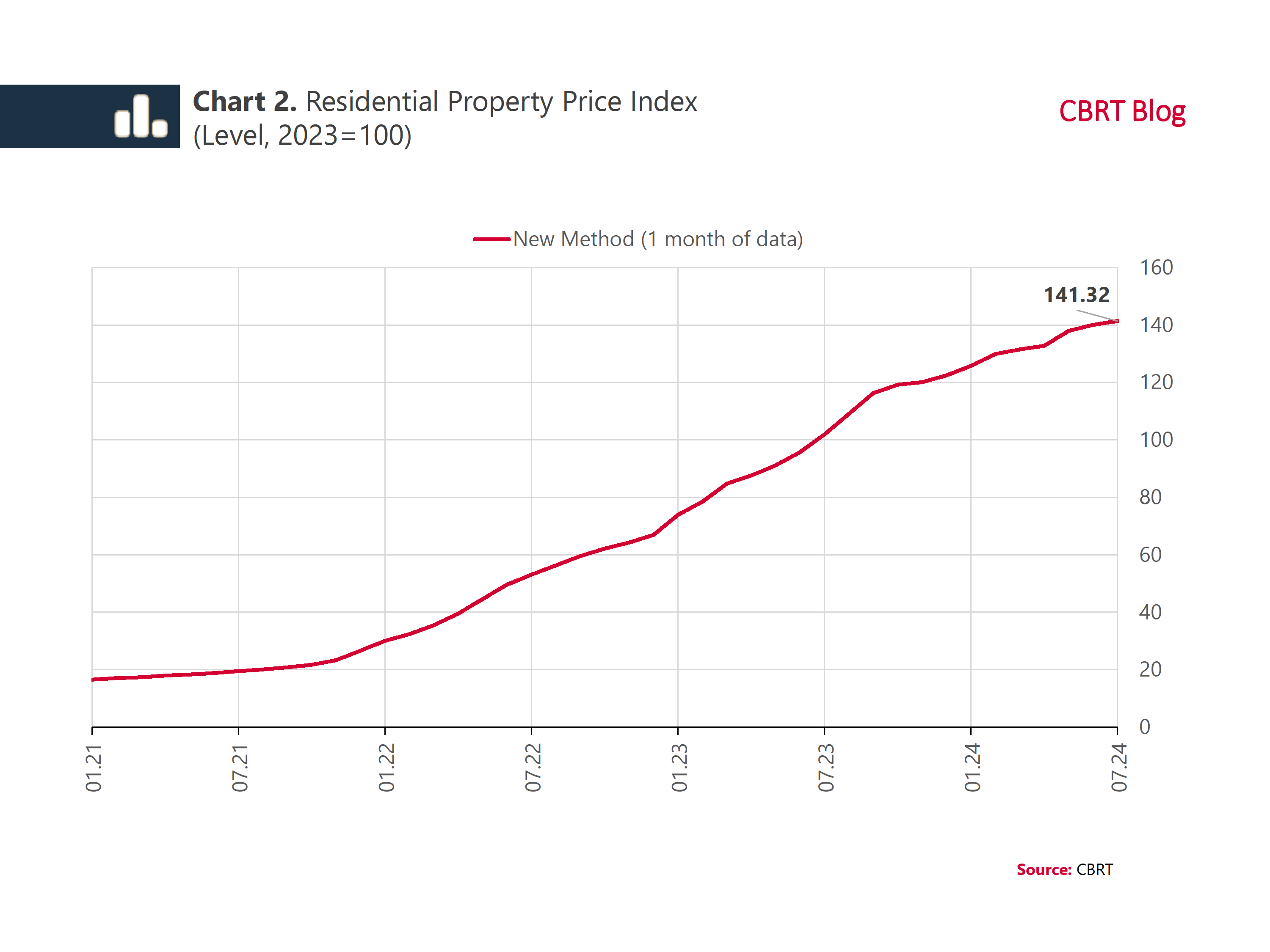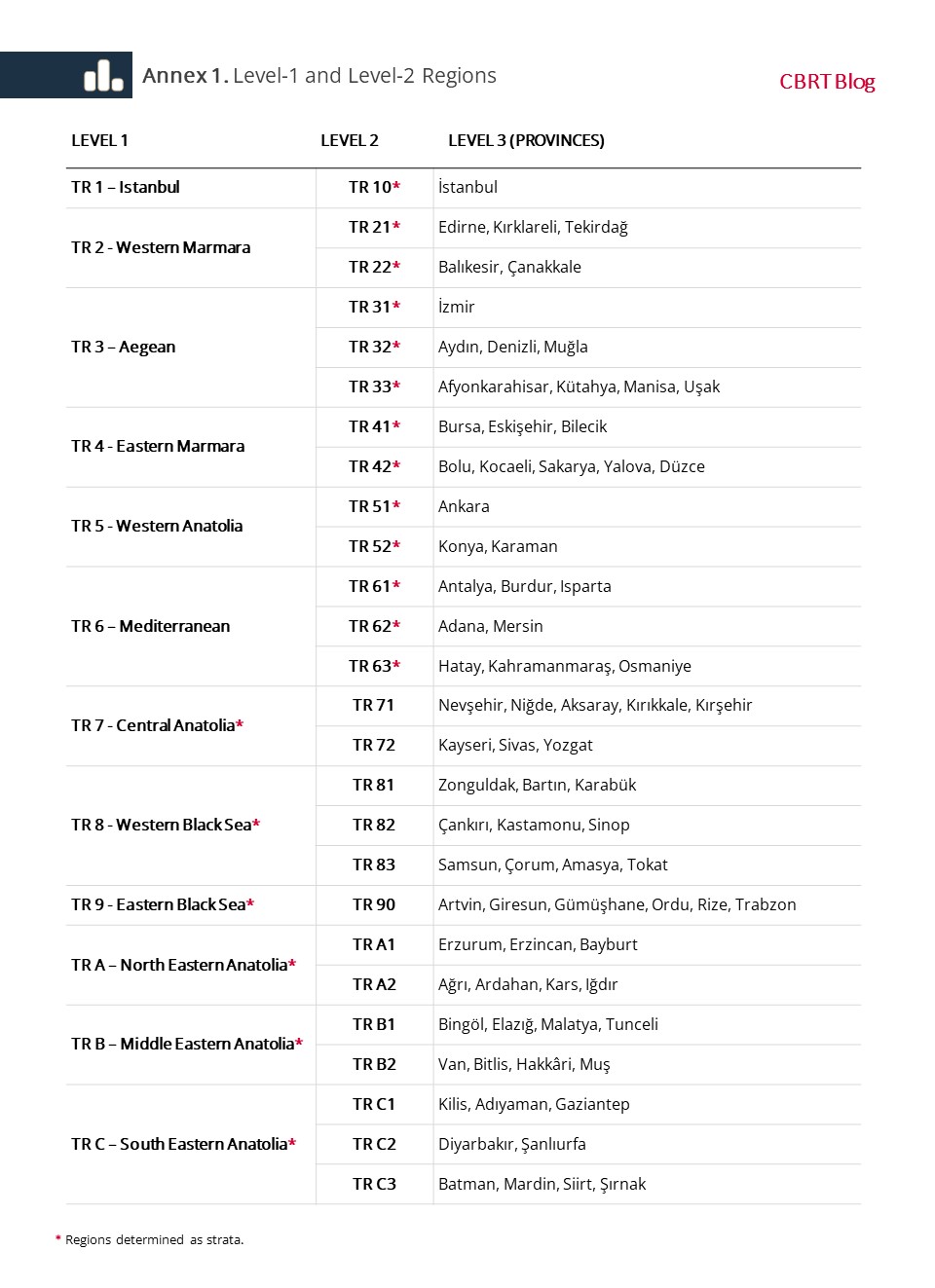The Central Bank of the Republic of Türkiye (CBRT) has been producing the Residential Property Price Index (RPPI) for Türkiye at a monthly frequency since 2012 based on the valuation reports compiled from banks. The RPPI was based on the change in stratified median prices[1] when it was launched and has been produced with the hedonic regression method that adjusts for the quality effect since 2016.[2] With the July 2024 publication, the CBRT changed the method of calculating the RPPI so as to provide the public monthly price changes in a way that provides more timely information. In this blog post, we summarize the scope of the revision as well as its effects on the indices.
Table 1 shows the main differences between the old and the new methods. Similar to the old method, the new method calculates the quality-adjusted price change using hedonic regression. However, the choice of the base period, the data set used for the analysis, regression levels, model variables, the weighting approach and publication breakdown have all been changed to a large extent.
The most significant difference between the two methods is that the new index is calculated using a monthly data set instead of a three-month moving data set. To illustrate with an example, in the old method, the data for April, May and June of 2024 were combined and the index calculated with this data set was published as the May 2024 index. However, in the new method, the May 2024 index value is calculated using only May data. As the calculations relying on the quarterly data set included the effects of the previous and the following month along with the title month, problem of timeliness could arise. This made it difficult to follow price developments accurately in periods of rapid changes in market conditions. Calculations made with a monthly data set eliminate this problem and allow for more accurate and timely observation of changes in the index in the face of cyclical developments. For example, in the pandemic period, the effects of the housing loan campaigns in June 2020 could be seen in the May index, which was calculated with April, May and June data in the old method of calculation and published in July (Chart 1). This may lead to an erroneous inference that house prices recorded a surge in May. The new method employing monthly data, on the other hand, shows that the highest increase in 2020 was recorded in June, when the campaign effect was seen.
Moreover, in the old method, since the index was calculated by combining three monthly data sets and announced under the name of the month in the middle, the publication period was t+45 days. However, since the new method of calculation employs monthly data, the RPPI can be announced in approximately t+15 days. Thus, the new method allows the July index to be announced to the public on 16 August 2024.
While the new method based on a monthly data set provides a notable gain in terms of timeliness, regression at the stratum level reduces the number of observations. To eliminate the risk of low number of observations, the regression analysis, which was conducted in more than 200 strata in the old method for district, province and level-2 breakdowns, is now conducted in 19 strata for level-1 and level-2 breakdowns in the new method. The province and district effects are controlled with dummy variables. In this context, the publication breakdown is also revised as "Türkiye, 13 level-2 and 6 level-1 regions" instead of "Türkiye and 26 level-2 regions" (Annex 1). In addition, the median housing unit m2 prices, which were previously published only for the three largest provinces, are now published at a quarterly frequency for all provinces with sufficient data, allowing for a more detailed comparison of the level of housing prices across provinces.
Another point where the new method differs from the old method is the weighting approach used when moving from levels to country level. While the old method was based on "the number of sales and the house value", the new method employs "the number of households and the house value". Thus, the effect of volatility in the number of sales that may arise due to regional shocks such as earthquakes on the weights is eliminated.
Finally, while the index was based on 2012 for the periods before 2017 and 2017 for the periods after 2017 in the old method, the data set is divided into four-year periods and the starting year of the relevant period is used as the base period in the new method. This eliminates the need to revise the base period that may arise in the future by taking into account the changing average housing characteristics in time.
According to the results produced with the new calculation method detailed above[3], the RPPI, which increased by 0.9 % in July 2024 compared to the previous month and rose to 141.32 level, increased by 38.7 % in nominal terms and decreased by 14.3 % in real terms compared to the same month of the previous year.

When the annual percentage changes of the old and new indices are compared, the new series appears slightly more volatile, as expected, but the two series are quite consistent (Chart 3). In May 2024, the last period when the indices are comparable, there was a difference of approximately 5 points between the two indices (Chart 4). Compared to the January 2010, the beginning of the series, the current level of the indices can be interpreted as a 28-fold increase in house prices according to the old method and a 30-fold increase according to the new method.[4]
As a result, in line with the emerging needs, methodological changes were made in the data set, strata, model variables and weighting used in the calculation of the RPPI, and the publication period was updated to t+15 days. This improvement is expected to contribute to the timely monitoring and evaluation of housing market developments by policymakers, market professionals and the public.

[1] The smallest units in which houses with similar characteristics are grouped geographically and the number of data is sufficient are defined as strata and the median value of the m2 unit prices in the valuation reports in each stratum is calculated.
[2] For detailed information on the method, please refer to TCMB - A Hedonic House Price Index for Turkey.
[3] The revised metadata is available on the CBRT website.
[4] It should be noted that in the old method, house prices in Adıyaman, Malatya, Hatay, Kahramanmaraş and Osmaniye provinces were considered constant due to the insufficient number of data resulting from the earthquake, which is one of the reasons for this difference.
